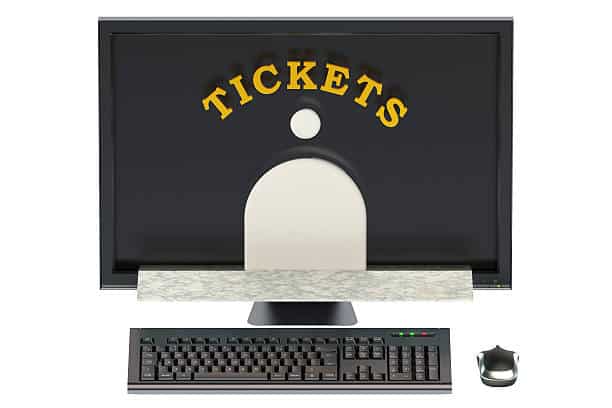As a business owner, you need more than a good website with good products. You need to set your business apart, which will involve providing customers with an interactive experience that reminds them there are people behind your brand, which is what an IT ticketing system will help your brand achieve.
As people are online often, if a customer has an issue with the product or service you offer, they will send emails or messages. And inboxes are overflowing as more people get online. That’s why several ticketing systems are on the market today to help both sides resolve difficulties and complaints.
What Is an IT Ticketing System?
An IT ticketing system is a tool used to track IT service requests, events, incidents, and alerts that might require additional action from IT. Furthermore, it helps organizations resolve internal IT issues by streamlining the resolution process.
Basically, an IT ticketing system helps manage and solve IT service requests, alerts, and incidents. It helps IT support teams work more efficiently and effectively by giving them tools for organization, automation, collaboration, and reporting. Also, a ticketing system can be free or priced.
The benefits of using an IT ticketing system include the following:
#1. Centralized Data
All the tickets are stored in one place, making searching, referencing, and analyzing for future cases easier.
#2. Organization and Prioritization
As support requests come in, they can be tagged, put into groups, and given to people. This makes it easier to organize and prioritize them.
#3. Automation
Automating specific tasks, such as ticket assignments and triage, saves time and helps prioritize tickets and tasks that need attention most.
#4. Reporting Tools
Built-in reporting tools help track response times, resolve tickets within a set time frame, identify pain points, and more.
#5. Collaboration
A ticketing system makes it easier for a team to work together by letting agents easily assign tickets to other team members, get help solving a problem, and make changes in real time.
Is an IT ticket system a CRM?
An IT ticket system is not precisely a CRM (customer relationship management) system but can be part of one.
A customer relationship management (CRM) system is a platform that stores information about leads and customers. Also, it automates certain marketing and sales tasks. On the other hand, an IT ticket system or help desk software is a tool that combines customer feedback to make support tickets easier to handle.
Depending on your business needs and priorities, you can add a helpdesk tool to your existing CRM or invest in a CRM system with built-in customer service features to serve your customers better.
What Is an Example of a Ticketing System?
A ticketing system is a help desk software program that processes, manages, and tracks customer issues from submission to resolution. It creates a document, or ticket, that records the interactions on a support or service case. Examples of a ticketing system Include:
#1. Zendesk
Zendesk is a ticketing system that is best for enterprise customer service teams. Using Zendesk, customer service teams can manage discussions across numerous platforms.
Features of the Zendesk Ticketing System
- Integration with other business systems
- Customizable dashboard and reports
- Data-driven insights
- Good ticketing system for small businesses
#2. HubSpot Service Hub
For teams looking for a central, cross-functional suite of tools, the HubSpot service hub is the best ticketing system. HubSpot is a good ticketing system for small businesses, and you can get started for free.
Features of the Hubspot Service Hub Ticketing System
- Ticket monitoring and progress tracking
- Integration with the HubSpot CRM
- Data for knowledge base creation and management
#3. Front Ticketing System
The front is an inbox management tool that can serve as a ticketing system. It is a hub that combines your online communication and customer support into one location. Also, front ticketing system is a good choice for teams that only provide support via email and small businesses.
Features of the Front Ticketing System
- Consolidating conversations from different channels like email, Facebook, Twitter, SMS, or phone into a single inbox
- Assigning support requests to yourself or teammates for clear accountability
- Using message templates for quick responses to common questions and assigning tags to support requests based on the area of expertise
#4. Jira Service Desk
Atlassian created Jira, which is a versatile ticketing system. It has a number of features that you can change to fit the needs of your team or project. IT and development teams can use the Jira service desk to manage assets, changes, issues, and projects, among other things.
Features of the Jira Service Desk Ticketing System
- Agile Implementation
- Integration with Atlassian tools
- Real-time reporting
#5. JitBit Ticketing System
The JitBit Ticketing System is a free, all-in-one help desk solution that gives users and support teams a wide range of features and benefits. It is a help desk software designed specifically for IT, SaaS, email, and more.
Features of the JitBit Ticketing System
- Web-based accessibility
- Hosted or self-hosted
- Email integration and file attachments
What Is the Tool Used for Ticketing?
Tools used for ticketing are called ticketing tools. Ticketing tools are management systems that handle, manage, and keep track of customer complaints and questions from submission to resolution.
When choosing a tool for ticketing, think about technical support, analytical reports, how easy it is to use, and how well it works with other tools.
Tools Used for Ticketing
There are different IT ticketing systems; the right one for your company will depend on your needs and the required features. Some examples of IT ticketing systems include:
- ServiceNow
- Zendesk
- HubSpot Service Hub
- Freshdesk
- Jira Service Desk
Each system has different features and functions, so it’s essential to compare them based on your business needs.
Is SAP a Ticketing System?
SAP has parts that can be used to make tickets, but it is not just a ticketing system. The platform provides a number of options for customer service, event ticketing, and customer relationship management.
Does Microsoft Have a Ticketing System?
Microsoft has no independent ticketing system, but you can make one using their existing products and integrations. Microsoft offers platforms that can be used as ticketing systems. Two main approaches can be used to utilize the Microsoft environment ticketing system.
#1. Using Microsoft Teams as a Help Desk
Using Microsoft Teams as a help desk requires no training for users already familiar with the platform. It encourages personalized experiences and is also easy to manage. However, it may not be as feature-rich as a dedicated ticketing system.
SharePoint and Forms are highly customizable, allowing you to create a ticketing system tailored to your needs. It also integrates with Power Automate to automate tasks and notifications. But it takes more time to set up and configure than Microsoft Teams, and it might not be enough for some advanced ticketing needs.
How is CRM Used in the IT Industry?
CRM, which stands for customer relationship management, is used in the IT industry to streamline processes, make them more efficient, and improve communication between all the people involved.
CRM systems help manage external interactions and relationships, centralizing customer and prospect contact information, sales opportunities, service issues, and marketing campaigns. Here are some ways CRM is used in the IT industry:
#1. Lead Generation and Management
CRM systems can help IT businesses automate lead generation and management processes. They can get customer information from different places, like websites, emails, phone calls, and social media, and put it all together. This allows for better tracking of leads and opportunities, making it easier to identify potential clients and close deals
#2. Sales Pipeline Analysis
CRM systems make it possible to look at the sales cycle in detail by tracking and documenting each process step. This helps companies identify issues and take steps to eliminate them, ultimately improving the efficiency of their sales operations
#3. Project Management
CRM systems can manage IT projects by assigning tasks, keeping track of progress, and allocating resources, among other things. This ensures that projects are completed on time and within budget, leading to increased customer satisfaction
#4. Customer Support and Service
CRM systems can be used to manage customer service and support, making sure that customer questions and problems are dealt with quickly and effectively across all channels. This helps maintain a positive relationship between the business and its clients
#5. Marketing Automation
CRM systems can manage and improve marketing campaigns and lead paths when they are based on data. This allows IT companies to target their marketing efforts more effectively and better understand the sales or prospects pipeline also.
#6. Onboarding New Clients
Onboarding workflows can be automated with a CRM system, which speeds up the process, therefore, ensuring that the customer has a good time. Additionally, by combining CRM with other business apps and tools, IT companies can make onboarding customers easier and get them more involved.
What Is the Difference Between a CRM and a Ticketing System?
Customer relationship management (CRM) and ticketing systems are useful in modern businesses for improving customer service and also making things run more smoothly.
Although they share some similarities, they serve different purposes, and their design addresses different aspects of the customer journey. A CRM ticketing system combines the benefits of both CRM and ticketing systems, allowing companies to manage their client database and support tickets in a centralized location
The main differences between CRM and ticketing systems are:
CRM Systems
- CRM systems primarily focus on gathering and managing customer information to facilitate sales and marketing efforts.
- Sales and marketing teams mainly use CRM platforms for lead generation and conversion.
- CRM systems offer a broader range of features to manage all customer-related tasks, including sales, marketing, and customer service.
- CRM systems encourage communication by initiating conversations with prospects to generate interest in products or services.
Ticketing System
- Ticketing systems aim to track customer communications and improve the customer experience by resolving issues.
- Customer service agents use ticketing systems to track and resolve customer requests and complaints.
- They are centered around problem-solving and incident management, providing customer-centric support when issues arise.
- Ticketing systems help reduce ticket volume by enabling self-service options and preventing unnecessary communication.
By knowing the differences between these systems, businesses can choose the best one for their needs.
Why Do Companies Use Ticketing Systems?
Companies use ticketing systems for various reasons, which can include:
- Improved Customer Service: Ticketing systems let agents view consumer interactions. They can serve customers without repeating queries.
- Organizing and Triaging Customer Requests: Ticketing systems make managing cases from several channels easier for customer care teams.
- Personalized Service: Ticketing systems give agents consumer information and help support workers organize and automate repetitive duties.
- Monitoring Agent Performance: Managers can utilize ticketing systems to track resolution, response, and first-reply times.
- Automating Repetitious Tasks: Ticketing systems can automatically assign tickets, change statuses, and also fill out ticket details.
- Increasing Revenue: Ticketing systems help firms stay organized and assist customers.
- Customer Satisfaction: Ticketing systems resolve technical issues quickly, therefore improving customer satisfaction.
- Team Productivity: Ticketing systems concentrate IT job details and automate regular processes, increasing team productivity.
Ticketing System Open Source
An open-source ticketing system is customer service software that lets anyone install, use, and also change the source code. Once the software is downloaded, it can be used as a simple help desk ticketing system to organize, track, and handle client questions and concerns.
The pros of an open-source ticketing system include the following:
- It has lower purchase costs and also greater customizability
- Community-driven product innovation
The cons of an open-source ticketing system include the following:
- It is not easy to use and is also difficult to set up and customize
- Limited support
Best Open-Source Ticketing Systems
- osTicket: This open-source ticketing system is free and helps scale and streamline customer service, therefore improving the customer experience.
- UVdesk: One of the best free, open-source ticketing systems available in the market
- FreeScout: A popular open-source ticketing system that offers free email management and analytics
- Redmine: A robust and free open-source ticketing system and web-based project management tool for managing many projects and subprojects, tracking time, and implementing role-based access control.
- BestPractical Request Tracker: A free, open-source ticketing system that can coordinate tasks, manage requests, track bugs, and optimize workflows.
- WHAT IS A HELP DESK? Examples and Software Solution
- 33 Best Event Management Software and Tools In 2023
- WORK TICKET: Meaning, Template & How it Works
- SERVICE EXCELLENCE: Meaning, Examples & What You Should Know






